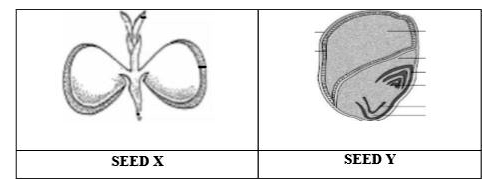Which of the following statements are true related to Seed X and Y?

(i) Seed X is dicot and endospermic or albuminous.
(ii) Seed X is dicot and non-endospermic or non-albuminous.
(iii) Seed Y is monocot and endospermic or albuminous.
(iv) Seed Y is monocot and non-endospermic or non-albuminous.
Choose the correct option with the respect to the nature of the seed
A
(I), (III)
B
(II), (III)
C
(I), (IV)
D
(II), (IV)
Video Solution
Text Solution
The correct Answer is:B
Embryos of monocots possess only one cotyledon. In the grass family the cotyledon is called scutellum that is situated towards lateral side of the embryonal axis. At its lower end, the embryonal axis has the radical and root cap enclosed in an undifferentiated sheath called coleorrhiza. The portion of the embryonal axis above the level of attachment of scutellum is the epicotyl.
In angiosperms, the seed typically consists of seed coat(s), cotyledon(s) and an embryo axis. The cotyledons are thick and swollen due to storage of food reserves (as in legumes). Mature seeds may be non-albuminous or ex-albuminous. Non- albuminous seeds have no residual endosperm as it is completely consumed during embryo development (e.g., pea, groundnut). Albuminous seeds retain a part of endosperm as it is not completely used up during embryo development Integuments of ovules harden as tough protective seed coats. The micropyle remains as a small pore in the seed coat.
|
Updated on:21/07/2023
Topper's Solved these Questions
- BOOK - EDUCART PUBLICATIONCHAPTER - SAMPLE PAPER 1 EXERCISE - SECTION-B24videos
SAMPLE PAPER 1
- BOOK - EDUCART PUBLICATIONCHAPTER - SAMPLE PAPER 1 EXERCISE - SECTION-C12videos
SAMPLE PAPER 1
- BOOK - EDUCART PUBLICATIONCHAPTER - SAMPLE PAPER (SELF-ASSESSMENT)-11EXERCISE - SECTION -C1videos
SAMPLE PAPER (SELF-ASSESSMENT)-11
- BOOK - EDUCART PUBLICATIONCHAPTER - SAMPLE PAPER 10EXERCISE - SECTION-C10videos
SAMPLE PAPER 10
Similar Questions
Knowledge Check
- Question 1 - Select One
A non-albuminous seed is
ASunflowerBGroundnutCBarleyDWheat - Question 2 - Select One
A dicot endospermic seed is
AorchidBzea maysCcastorDoryza sativa - Question 3 - Select One
In non edospermic seed or ex-albuminous seed
AThe endosperm may be completely used up by the developing embryoBNo endosperm formCEndosperm is starchyDEndosperm is oily
Which of the following plant has endospermic seed?
View SolutionWhich one of the following is non-endospermic seed
View SolutionA dicot albuminous seed is
View SolutionNon endospermic monocot is
a) Castor and gram
b) Maize and mulethi
c) Tomato and moong
d) OrchidView SolutionSeeds are endospermic in :
View Solution
